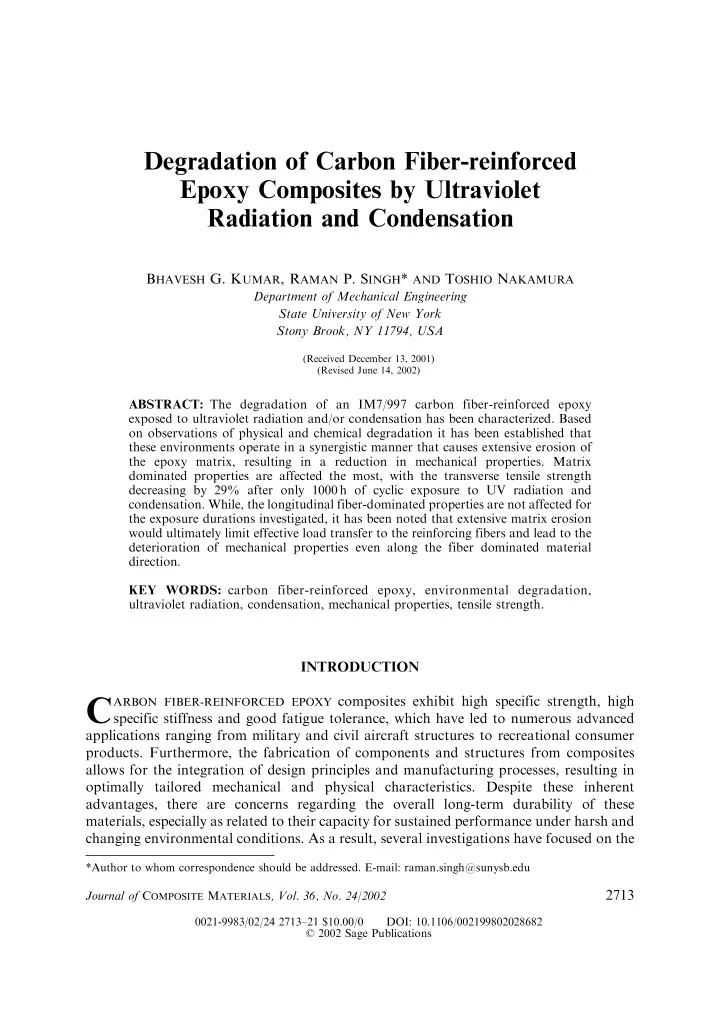

Degradation of Carbon Fiber-reinforced Epoxy Composites by Ultraviolet Radiation and Condensation B HAVESH G. K UMAR , R AMAN P. S INGH * AND T OSHIO N AKAMURA Department of Mechanical Engineering State University of New York Stony Brook, NY 11794, USA (Received December 13, 2001) (Revised June 14, 2002) ABSTRACT: The degradation of an IM7/997 carbon fiber-reinforced epoxy exposed to ultraviolet radiation and/or condensation has been characterized. Based on observations of physical and chemical degradation it has been established that these environments operate in a synergistic manner that causes extensive erosion of the epoxy matrix, resulting in a reduction in mechanical properties. Matrix dominated properties are affected the most, with the transverse tensile strength decreasing by 29% after only 1000 h of cyclic exposure to UV radiation and condensation. While, the longitudinal fiber-dominated properties are not affected for the exposure durations investigated, it has been noted that extensive matrix erosion would ultimately limit effective load transfer to the reinforcing fibers and lead to the deterioration of mechanical properties even along the fiber dominated material direction. KEY WORDS: carbon fiber-reinforced epoxy, environmental degradation, ultraviolet radiation, condensation, mechanical properties, tensile strength. INTRODUCTION ARBON FIBER-REINFORCED EPOXY composites exhibit high specific strength, high C specific stiffness and good fatigue tolerance, which have led to numerous advanced applications ranging from military and civil aircraft structures to recreational consumer products. Furthermore, the fabrication of components and structures from composites allows for the integration of design principles and manufacturing processes, resulting in optimally tailored mechanical and physical characteristics. Despite these inherent advantages, there are concerns regarding the overall long-term durability of these materials, especially as related to their capacity for sustained performance under harsh and changing environmental conditions. As a result, several investigations have focused on the *Author to whom correspondence should be addressed. E-mail: raman.singh@sunysb.edu 2713 Journal of C OMPOSITE M ATERIALS , Vol. 36, No. 24/2002 0021-9983/02/24 2713–21 $10.00/0 DOI: 10.1106/002199802028682 � 2002 Sage Publications
2714 B.G. K UMAR ET AL . performance of fiber-reinforced composites when exposed to moisture, temperature, ultraviolet (UV) radiation, thermal cycling and mechanical fatigue [1]. However, the resulting degradation mechanisms are quite complex and usually dependent on the testing configuration and the specific material being investigated. This requires extensive experimental characterization of fundamental degradation mechanisms prior to the development of generalized models for predicting material behavior and long-term reliability. Furthermore, composite materials are typically exposed to multiple environ- ments during service, which leads to the possibility of synergistic degradation mechanisms. Nevertheless, few investigations focus on the controlled determination of synergistic mechanisms. For example, combined exposure to UV radiation and water vapor, which are predominantly responsible for degradation during outdoor service, has received only limited attention [2–4]. In light of these issues, this investigation is focused on characterizing the physical, chemical and mechanical degradation of an advanced carbon fiber-reinforced epoxy composite following exposure to UV radiation and/or moisture (in the form of condensation). The objective is to explore the fundamental modes of degradation, establish synergistic mechanisms and thus provide a fundamental basis for predictive modeling of structural durability under these conditions. Both UV radiation and moisture have adverse effects on the mechanical properties of the polymeric epoxy matrix, while the carbon fibers are not affected significantly by either environment. The polymer matrix in a fiber-reinforced composite serves to transfer applied loads to the reinforcing fibers and provide interlaminar shear strength, whereas the fiber– matrix interface governs the load transfer characteristics and damage tolerance. Thus, both these components represent weak links in fiber-reinforced composites and upon degradation, lead to reduced damage tolerance, and thus, lack of long-term durability. The UV components of solar radiation incident on the earth surface are in the 290– 400 nm band. The energy of these UV photons is comparable to the dissociation energies of polymer covalent bonds, which are typically 290–460 kJ/mole. Thus, UV photons absorbed by polymers result in photo-oxidative reactions that alter the chemical structure resulting in material deterioration [5]. These chemical reactions typically cause molecular chain scission and/or chain crosslinking. Chain scission lowers the molecular weight of the polymer, giving rise to reduced strength and heat resistance. On the other end, chain crosslinking leads to excessive brittleness and can result in microcracking. Photo-oxidative reactions can also result in the production of chromophoric chemical species, which may impart a discoloration to the polymer, if they absorb visible wavelengths. Furthermore, an autocatalytic degradation process is established if UV-absorbing chromophores are produced. Often, the formation of these groups serves as a convenient means of monitoring the deterioration process. Various photostabilizers may be added to polymers to slow down degradation by UV radiation. However, long-term exposure to UV radiation can still result in significant deterioration of mechanical properties, especially under conditions involving high ambient temperatures. In contrast with the coatings literature, there are far few investigations that focus on the effects of UV radiation on the degradation of mechanical properties of fiber-reinforced polymer matrix composites [3,6–10]. For relatively short periods of exposure, only changes in surface morphology are observed [3,7]. However, for extended exposure to UV radiation, matrix dominated properties can suffer severe deterioration, e.g. interlaminar shear strength and flexural strength and flexural stiffness can all decrease [6,9,10]. The fiber-dominated properties, such as tensile modulus and tensile strength, are usually not affected significantly, especially for carbon fiber-reinforced materials [3,9].
Recommend
More recommend